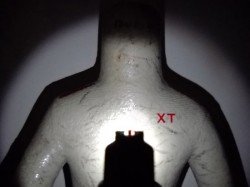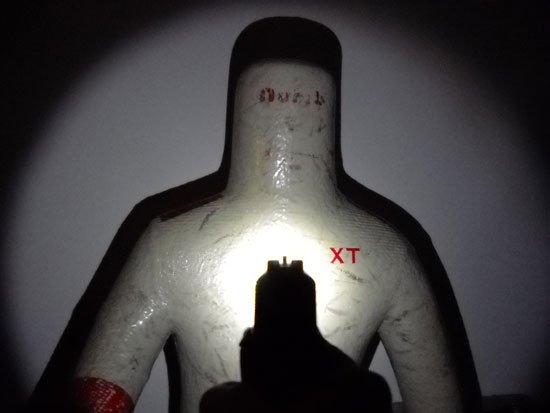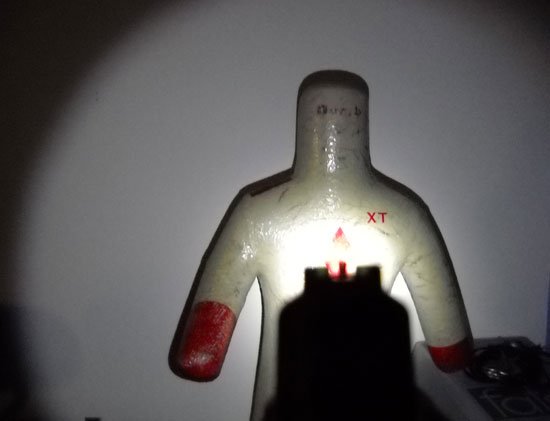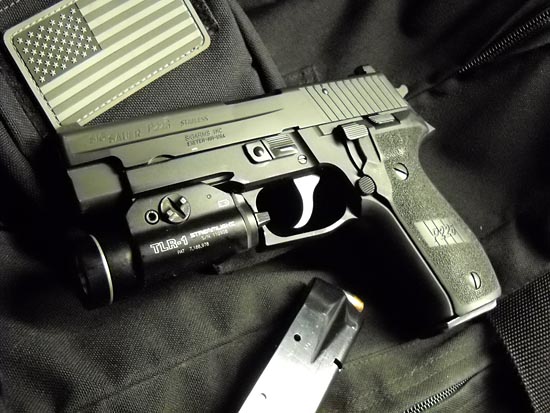
If you already have a weapon-mounted flashlight, then by default you possess a quick firearm aiming device…if you do a bit of homework!
Laser sights are all the rage and I confess to having purchased a couple. But they are not always financially justifiable or even allowed by policy for many coppers. At half the price, a tactical light can give you a similar service in a very close combat situation.
During night fire sessions at the range, some of our shooters began to notice that they were getting a flash sight picture from their handgun-mounted lights. At distances of five yards or less, the flashlights were illuminating center of mass on the targets and approximating point of impact.
A simple test is to unload and safety check your duty gun. Look over the sights at a wall at distances from one to seven yards. Turn on the light. If your sights are properly adjusted, the beam of your flashlight will give you a general aiming point.
For me, the Streamlight TLR-1 on my SIG SAUER P226R projects a circle of light where my bullet’s point of impact is near 12 o’clock in the beam’s hotspot. I have shot many groups at the range and trust this orientation out to five yards.
The Surefire lights on my H-K MP-5 and Remington 870 were also “minute-of-man” at close range during actual shooting drills.
Where is this important? At CQB distances in room clearing, I am confident that, with the light on, punching out at the target and sending rounds into the beam’s focal point will give me center of mass hits.
I am not advocating this as a primary sighting method over either sighted fire or instinctive shooting. I am just observing that in a critical incident and under stress, knowing where your bullets impact in the target illumination can be an advantage, because that is where your visual focus will be.
In addition, knowing this can help you pick up your sights quicker in low or no light scenarios, where it can be difficult or impossible to find gunsights that lack tritium or fiber optic tubes.
When we do high risk building clearing or search work in the dark, we naturally look where we are lighting, but not necessarily with a full sight picture. I feel that using the flashlight as an aiming guide brings me on target faster.
Most of the current LED tactical lights I have encountered have a beam that gives you a spotlight in the center and floodlight in its periphery. The size and intensity of the spot vary with the type of light.
Even the older incandescent bulbs throw a nice fixed point of light close up. An ancient Surefire is affixed to my issued 870. Since the shotgun has only the bead for a sight, knowing my 00 buck patterns hit right down the center of the light’s beam under ten yards is a bonus.
I started out by comparing the flashlight to a laser. And I’ll continue this by saying one is a hammer and one is a scalpel, as tools go. The tactical flashlight can assist you in getting rounds on a target. A well-adjusted laser surgically pinpoints your rounds on a target.
Next trip you have to the range for low light practice, try a few snap shoot drills at close quarters battle with the tactical flashlight. I hope it is useful for you.




Randall is a twenty-four year veteran officer of a mid-size Florida police department. He served as a SWAT team officer for over 21 years, to include 12 years as a Team Leader. He is currently the K9 Unit Sergeant and department SWAT Coordinator.